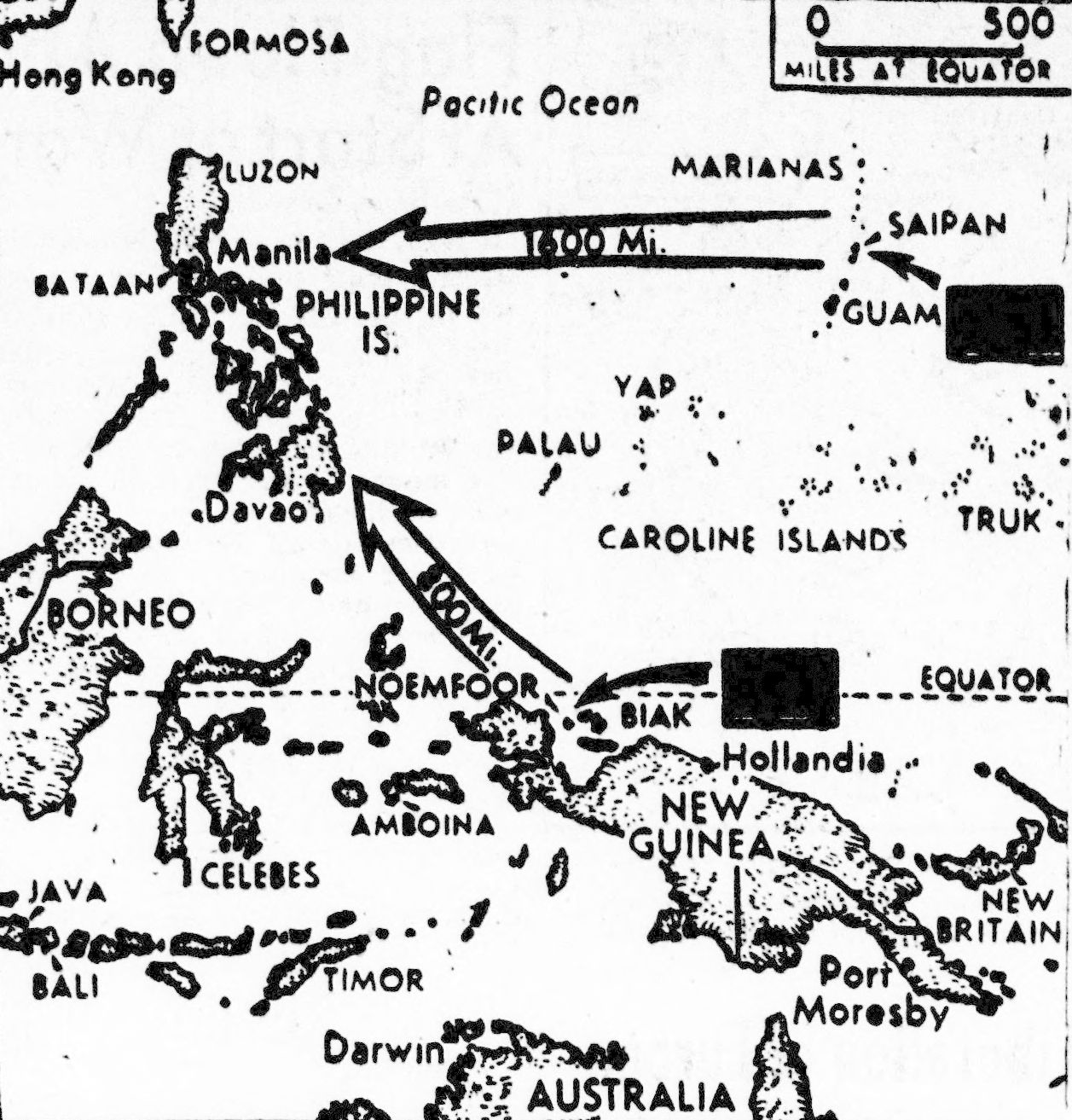U.S. Navy Department (June 28, 1944)
Naval advance to the westward
For Immediate Release
June 28, 1944
The advance of our naval forces to the westward began with the reoccupation of Attu and Kiska in the far north, and the capture of the most important islands in the Solomons group in the far south.
From our far northern bases we began attacking the Japanese Kurils from the air. We have also made several surface vessel bombardments against the enemy’s shore installations in the Kuril chain.
In the south, the successful termination of the Solomons campaign made possible air and surface raids against Japanese garrisons in the Bismarck Archipelago and along the northern New Guinea Coast.
With our positions in the far north and in the south firmly established, the next step was the squeeze made in the middle of the enemy’s perimeter. This resulted in the capture of the Gilbert Islands. Following that, the Marshall campaign then gave us Kwajalein, Majuro and Eniwetok. Farther to the south we took the Admiralty Islands and also important positions on New Britain. Then strategic areas along the northern New Guinea coast fell to us with the result that we were then able to launch air and surface attacks against Truk, Ponape, Kusaie and other islands in the Caroline group, from several directions. We also were able to strike from Australia in the far south against Japanese positions in Java. But it was the capture of certain of the Marshalls group that permitted us to launch our surface and air attacks as far west as Palau, Guam, Saipan, Rota and the Bonin Islands.
Our last offensive blow, aimed in the ultimate capture of Saipan, has already permitted our air and surface fleets to strike still farther westward. The final occupation of Saipan will enable us to project surface and air operations that will include the mainland of Japan, the Philippines and a greater part of the Dutch East Indies.
CINCPAC Communiqué No. 65
U.S. Marine and Army troops have made further gains on Saipan Island, pushing north nearly two miles along the east coast, passing the villages of Donnay and Hashigoru: On the west coast, further penetrations have been made into Garapan Town. Enemy troops broke through our lines containing them on Nafutan Point on the night of June 26 (West Longitude Date), and attempted to drive northward. Two hundred enemy troops were killed in this counterattack. The next day, further attacks were launched by our forces against Nafutan Point and the enemy now holds only the extreme tip of the point.
Close support is now being given our troops by shore‑based aircraft operating from Aslito Airdrome. Tinian Island has been subjected to protracted daily bombardment to neutralize enemy positions there.
On the night of June 25, several enemy torpedo planes attacked a carrier group screening our transports. Several torpedoes were launched, but no hits were obtained. One enemy plane was shot down, and another probably shot down. During the night of June 26‑27, enemy aircraft again attacked our transports, but all bombs landed in the water. One near miss on a transport injured a member of the crew.
Surface units of the Pacific Fleet bombarded Kurabu Zaki at the southern tip of Paramushiru in the Kurils on the night of June 25‑26.
Paramushiru and Shumushu Islands were bombed by Liberators of the 11th Army Air Force and Ventura search planes of Fleet Air Wing Four before dawn on June 25 and 26. Several fires were started in these raids. Anti-aircraft fire was intense. Eleven enemy fighters attacked a single Ventura of Fleet Air Wing Four near the airfield at Paramushiru before dawn on June 26. Two of the attacking planes were damaged, and one disappeared into a fog bank trailing smoke. The Ventura returned with superficial damage.
Carrier aircraft swept Guam and Rota Islands in the Marianas on June 26. Fuel reservoirs and coastal defense gun positions were bombed. three small craft in Apra Harbor at Guam were destroyed. The cargo vessel damaged in previous strikes was observed to have sunk. At Rota, the airstrip was strafed and buildings were set afire. There was no enemy air opposition during these attacks.
Truk Atoll was bombed by 7th Army Air Force Liberators on June 25. One of five enemy fighters which intercepted our force was shot down. We suffered no damage. Army and Marine aircraft attacked enemy objectives in the Marshalls on June 25.
An enemy twin‑engine bomber was shot down south of the Hall Islands by a search plane of Fleet Air Wing Two, Group One, on June 26. The same day, an enemy torpedo plane was damaged by another search plane northwest of Truk.
